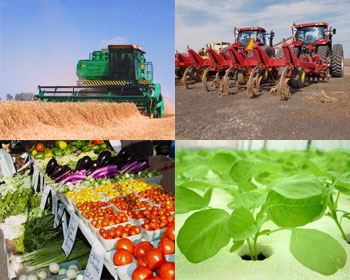A Publication of the
Applied Math and Science Education Repository

The AMSER Science Reader Monthly aims to provide educators with a useful package of information about a particular topic related to applied math and science by combining freely available articles from popular journals with curriculum, learning objects, and web sites from the AMSER portal. The AMSER Science Reader Monthly is free to use in the classroom and educators are encouraged to contact AMSER with suggestions for upcoming issues or comments and concerns at [email protected].
This month's AMSER Science Reader Monthly topic is Sustainable Agriculture.
How to feed a hungry world
Article
by Nature Editorial Board
Synopsis and resource annotations by Max Grinnell

The question of how to feed the world's population is one that has troubled scientists and scholars all the way back to the ancients. Recently, many have asked how to continue feeding the world's people without wreaking havoc on the planet. This editorial from the July 28, 2010 edition of Nature takes a close look at how to produce enough food for the world's population over the coming decades and how to do it at an acceptable cost to the planet.
The piece starts by providing a bit of background on world population growth trends, and then asks the pressing question: "How to expand agricultural output massively without increasing by much the amount of land used." The editorial discusses the importance of a "second green revolution", which would effectively lead to a sustainable intensification of global agriculture.
Moving along, the piece examines some of the potential barriers to reaching the goal of increased sustainable production. One barrier is that private agribusiness companies seem reticent to invest in agricultural infrastructure, due to relatively small or nonexistent profit margins. Another potential problem is that the growth in public agricultural-research spending peaked in the 1970s, and it has decreased since then in countries across sub-Saharan Africa, where food needs are rather intense.
Finally, the piece concludes by noting that poverty is the real root cause of world hunger, and that market volatility was one of the main causes of the 2008 food crisis. Readers will also want to make use of the many resources offered at the end of the piece, and they include news features (such as "The Global Farm"), opinion articles, and a podcast titled "Future Food".
Found below is a list of useful resources that will illuminate and enhance understanding of the topics found within this article. The first link will take visitors to the Future Agricultures website, which contains reports, a blog, and publications related to the global food system and agricultural improvements. The second link will lead visitors to the Biodiversity Food and Agriculture Organization (FAO) section of the United Nations website. Here interested parties can learn about their work on encouraging biodiversity in order to alleviate world hunger. The third link leads to a fascinating report from the International Development Resource Centre (IDRC) about urban agriculture, and how it might be an integral part of sustainable development. Moving on, the fourth link leads to the USDA's Sustainable Agricultural Research and Education site. Educators will appreciate the resources contained within the "For Educators" area here. The fifth link leads to the Union of Concerned Scientists: Food and Agriculture site, which includes information on Genetic Engineering, Pharma Crops, and the impacts of Industrial Agriculture. The final link leads to an excellent site provided by the United Nations Educational Scientific and Cultural Organization (UNESCO). The site provides educators with lesson plans and interactive modules designed to help them discuss the principles of sustainable development in the classroom.


